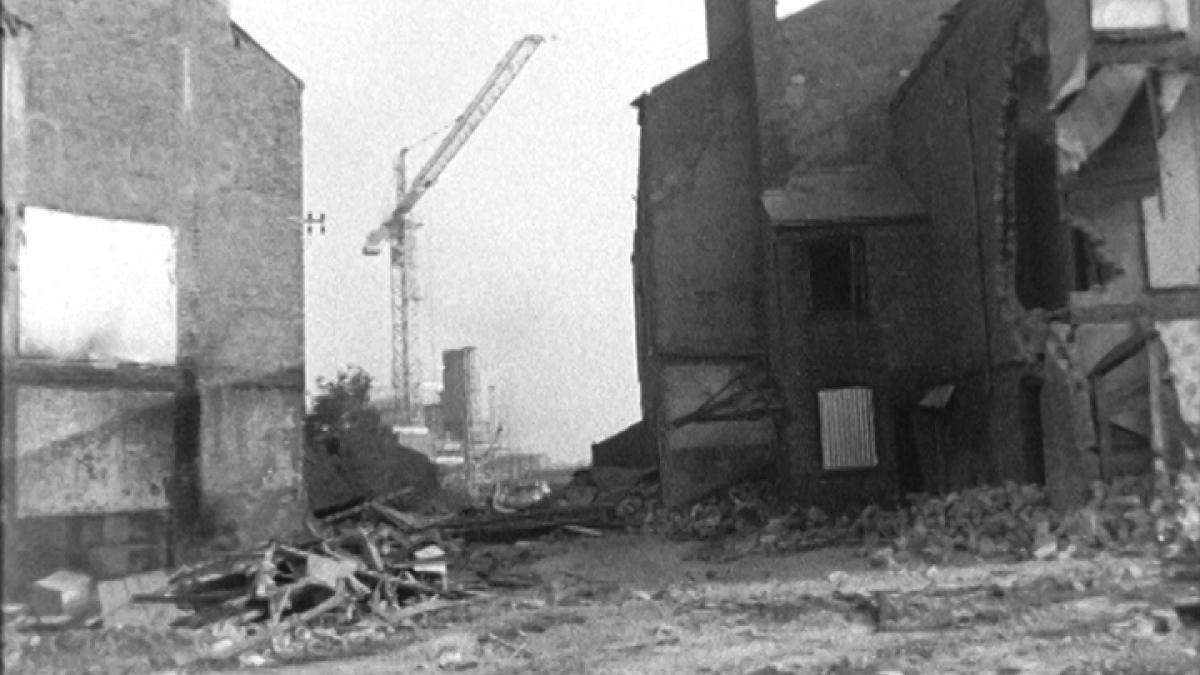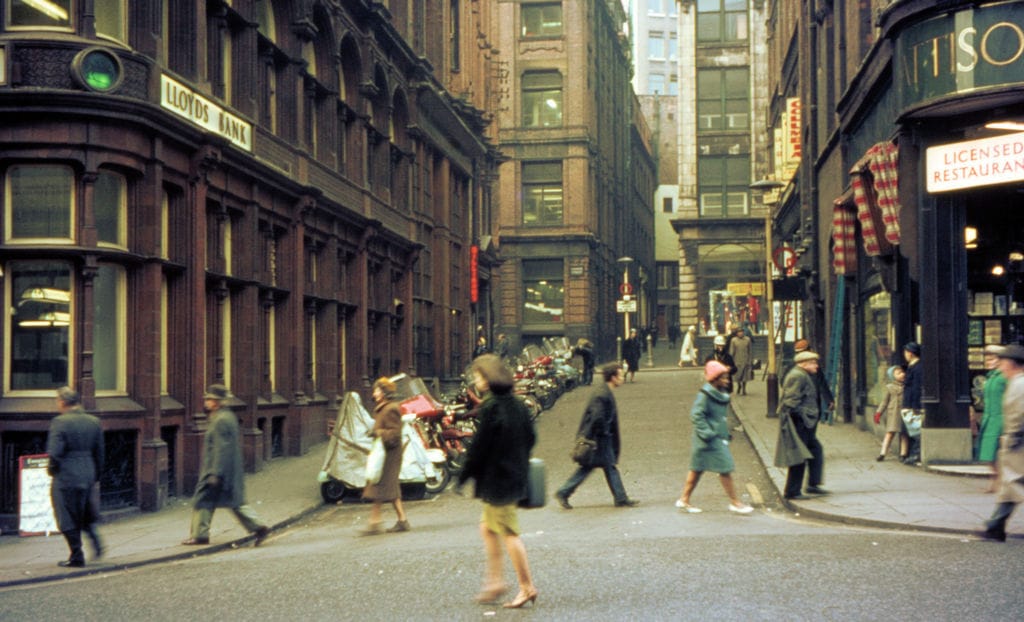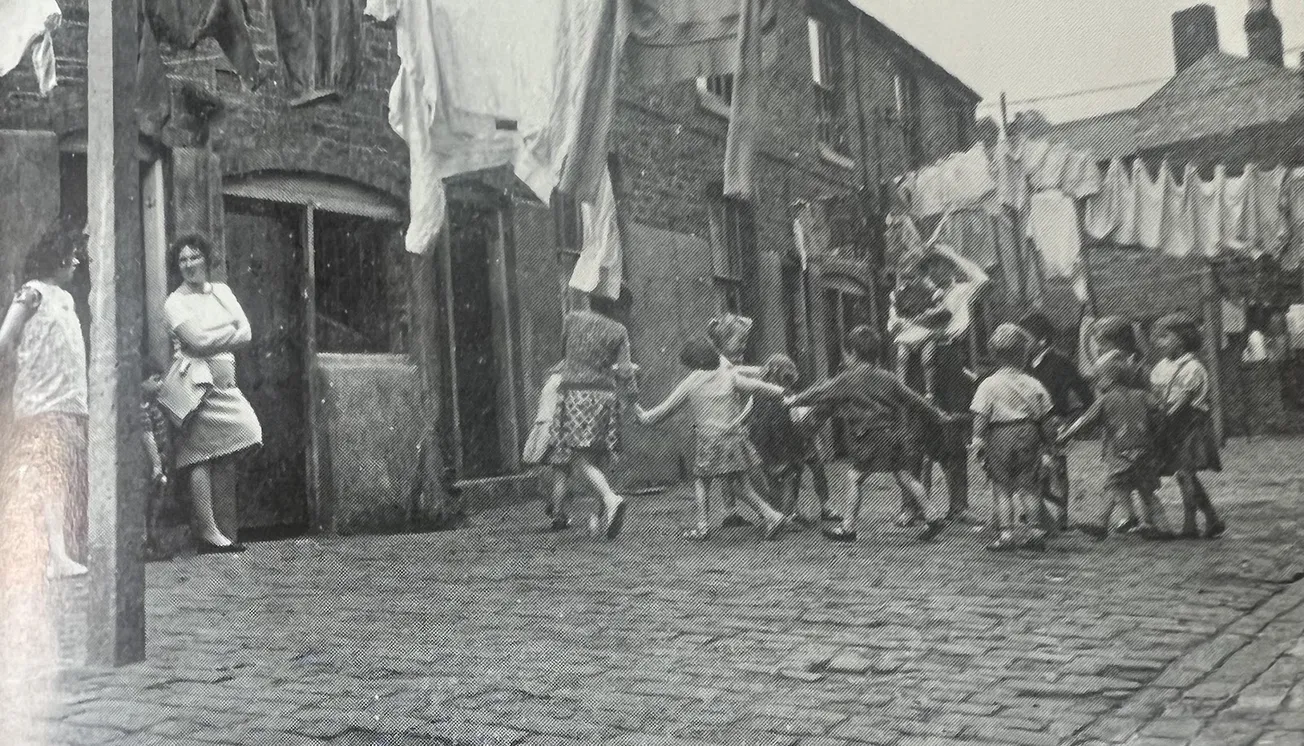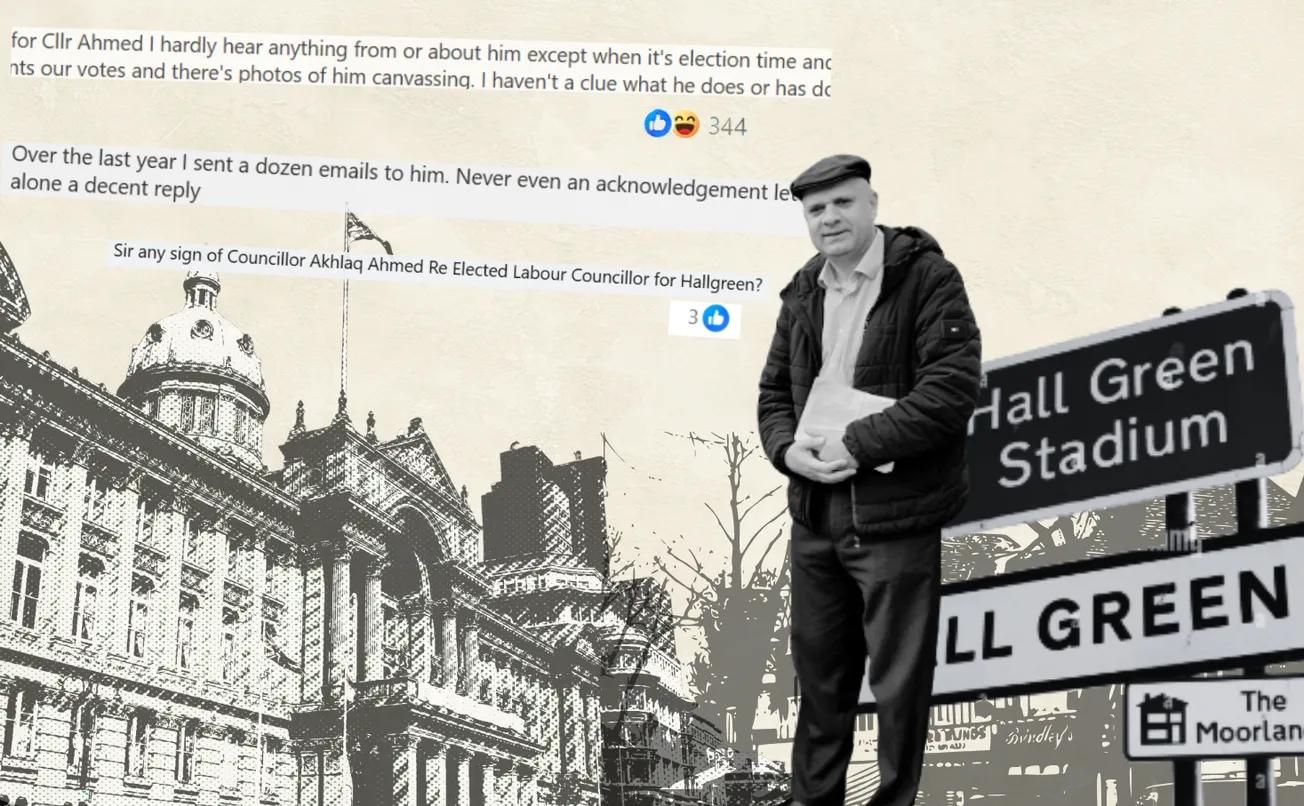In 1952, Norman Power, a young, idealistic vicar, took up a position in Ladywood.
It was a desperately poor place, full of back-to-back slums organised around unsanitary ‘courts’, all mingled with workshops and small factories. But it also had streets featuring better quality housing, home to a small, integrated middle class. Most of all, 1950s Ladywood possessed a strong sense of community.
Power had grown up in Birmingham before going to public school and then Oxford. Coming back to his home city, he was keenly aware of the terrible state of housing in many parts of his parish, and initially supported Birmingham Council’s plans to redevelop it, along with vast swathes of the rest of the inner city. After all, wasn’t Birmingham suffering the worst postwar housing crisis in England after Liverpool?
Overcrowding, death, disease and infant mortality in Victorian Birmingham, while dire, had never been quite as bad as some other cities, like Manchester. This meant it was late to regulate building and late to begin clearing slums. It was late to build council houses too; and although when it got going it famously built more than anywhere else, they were in cottage estates like Kingstanding rather than in the old heart of the city.
This meant that the warren of tiny houses built during the industrial revolution, packed cheek-by-jowl into courts accessed through tunnels from larger street-facing homes, had survived relatively intact into the 20th century. Despite scattered improvements, many lacked basic amenities, were dark and airless, suffered from damp and pest infestation, or were simply utterly filthy.
Since the introduction of building by-laws in 1876, people had been leaving these areas and moving out to new, more spacious terraces in areas like Sparkbrook. This process continued with the cottage estates and garden suburbs. But in the early 20th century, Birmingham’s economy boomed and its population soared. Unlike other industrial cities, the decrepit inner city stopped losing people; in some places it was even gaining them. Birmingham’s housing problem was getting worse.
After WWII, the council set about improving things. The inner city — an area containing around 30,000 homes and perhaps 100,000 people — was earmarked to be razed to the ground and redeveloped in a more humane way. The idea was to build modern houses with gardens and green space. There would be separate residential, industrial and retail zones — no more polluting industry randomly set among the slums. And no more private slum landlords; new residents would all rent from the council. Ladywood was one area deemed ripe for the revolution.
The ultimate architect of these plans was Herbert Manzoni, City Engineer and the only person in the whole country to control a council’s planning, architecture and engineering functions. Manzoni was determined to clear the city of its slums — particularly, it seems, if they stood in the way of his road plans.
But as it turns out, knocking things down is much easier, and quicker, than building them — although it does make it simpler to erect dual carriageways. Ladywood became pockmarked by half-demolished derelict houses, all awaiting the slower process of rebuilding. Shops shuttered as their customers moved out.
Meanwhile, Norman Power became increasingly angry. about the complete destruction of the physical and social fabric of the area.
In his 1965 book about his parish, The Forgotten People, Canon Power christened these rubble-strewn areas ‘the waste land’, arguing they were leading to a collapse in local pride and an increase in antisocial behaviour.

He was also baffled by the council’s priorities; the best properties — larger houses with gardens, not back-to-backs — were demolished first, while some of the worst slums were left standing well into the 1960s. Power highlighted the west side of Monument Road, where there were “tiny, damp, huddled dwellings [that] are unfit for habitation. In the Anderton Street area is some of the worst property I have ever seen… These houses remain!”
Even finished, Ladywood, and areas like it, would house far fewer people, particularly as the new dual carriageways, widened streets like Summer Row and Bristol Street would also take up space once occupied by homes. A large section of the population would be forced to move out as a result, to designated overspill towns such as Tamworth, Redditch, Daventry and Worcester, or to new estates within the city or on the outskirts. There was no public consultation but there is evidence that many wanted to stay in their communities.
Enjoying this edition? You can get two totally free issues of The Dispatch — including our Monday news briefings and the weekend read you're perusing right now — every week by signing up to our regular mailing list. Just click the button below. No cost. Just old school local journalism.
The effect was to erode Ladywood’s social glue, breaking up bonds of family that had existed for decades, if not longer. This was not just about links between working class families — some better-off families, including local doctors and teachers, had once lived in the more spacious terraces and the larger Georgian houses. But the new homes would all be council-owned and designed for workers.
Ladywood had always been an overwhelmingly working-class area, but after the slum clearances it would become exclusively so. Power was supportive of social housing, but he wanted some private homes alongside them, sustaining a more mixed community.
He was also increasingly sceptical of the high-rise flats that arose in the early 1960s, arguing that they were totally unsuitable for many of his parishioners, especially families and older people who were increasingly isolated from their support networks. He was remarkably prescient; within a decade or two, these tower blocks would be regarded as a new form of urban slum.
What Power described was occurring simultaneously almost everywhere else in the inner city, with dramatic effects not just on people and communities but, given the scale of dereliction and abandonment, on a more general pride in Birmingham and a sense of civic identity.
It is not as if what replaced the slums was of a particularly high quality — the council preferred to work with large engineering contractors rather than housebuilders or independent architects and the early designs were basic rows of houses. .
A new vision
Enter Alwyn Sheppard Fidler. In 1952, he became the first City Architect of Birmingham who was supposed to change tack.
Sheppard Fiddler was a talented and thoughtful architect, genuinely interested in urban design, although his plans were very much of their time. The Lyndhurst Estate in Erdington and the Primrose Hill estate in King’s Norton were his most acclaimed work, but his influence can also be seen in much of the rebuilt inner city.
His preference for 'Radburn' layouts – separating pedestrian and vehicle routes, concentrating once scattered local shops in neighbourhood centres – turned out to be perfect for antisocial behaviour. The lack of enclosed streets, and the plentiful space between buildings, created a windswept feel.
Despite clashing with Manzoni frequently — the City Engineer felt Sheppard Fidler cared too much about architecture at the expense of sheer housing numbers — his designs meshed well with his colleague’s road plans. The result, in the inner city, was a scattering of inward-looking housing developments separated by barrier-like dual carriageways.
The shift to high rise flats began as part of Sheppard Fidler’s credo of ‘mixed development’, but it was mainly a response to a simple fact: the city was running out of land. By the early 1960s, there was little remaining within the city boundaries.
A programme of tower blocks was supported nationally by the Conservative government at the time, who were keen to boast about housing numbers but concerned about irritating their rural voting bloc by allowing cities to expand.

New subsidies were introduced. Keith Joseph, the then-Housing Minister and later a close ally of Margaret Thatcher, was an enthusiastic proponent of pre-fabricated buildings that would allow high-rises to be constructed much more rapidly.
Birmingham, a metropolis of vital national economic importance, and with one of the gravest housing shortages in Britain, would be the testbed for these ideas; the city council was keen to rise to the challenge. Pre-fabs and tower blocks would allow it to jump ahead of its peers in delivery, particularly if they made use of their existing contacts with contractors. Birmingham’s leaders took the message to heart — a scandal followed, which saw Sheppard Fidler resign in protest. In 1975 one of his successors, Alan Maudsley, appeared in court to plead guilty to corruption in his dealings with Bryant, the contractor appointed to carry out much of the construction work on the new blocks.
The last of the slums?
Meanwhile, Birmingham was already beginning to take a different approach to urban renewal. After a community backlash, plans to level and redevelop areas such as Balsall Heath — considered better quality than the slums of Ladywood — were shelved. The emphasis moved to refurbishment and restoration, often of privately-owned property. The era of comprehensive redevelopment and tower blocks was over.
During little more than two and a half decades, up to 50,000 homes had been demolished and around 150,000 people, perhaps 15% of the city’s population, displaced. Every back-to-back vanished, except isolated examples now owned by the National Trust on Hurst Street.
However, an estimated half of all homes in the inner ring were standard street terraces with gardens or yards, but that did not stop the vast majority of them being swept away too. The picture below, for example, shows the area around long-gone Prescott Street in Hockley just after the war. The top half is covered in back to backs, but ‘through’ terraces dominate the bottom half.
No other city in England did such a thorough job of erasing its Victorian inner city over such a short time period — although Manchester perhaps comes close. Certainly, no other was rebuilt with such haste and, at times, with so little concern for quality. No other city forcefully moved so many people out to its outskirts. But then again, no other city was growing as fast as Birmingham or had such pressing housing shortages.
The combination of such vast demolition and the design ideas of the post-war period created a rather empty-feeling bleak and windswept inner city. It was redeveloped at a time when the Victorian city, and the very idea of urban density, was regarded with horror.
In a different era or place, the better-through terraces would have survived, and perhaps even some of the improved back-to-backs. The old street plan, often replaced by cul-de-sacs and curving roads, might have been kept and new, modern rows of houses built into it. More people would have been able to stay with their family and friends, and the inner city might be more diverse and lively as a result.
Instead, alongside the notorious social problems of a lot of inner city Brum, the relative lack of people in inner wards compared to most European cities affected the vibrancy and economic vitality of the city centre, as fewer people lived within commuting (or shop or nightlife) distance of the core. Public transport is also harder to justify.
The fact that older, denser housing survived in the middle ring has produced a strange dynamic, where many of the neighbourhoods a couple of miles further out can feel more vibrant and urban than the area just outside the city centre.
As well as the problems of the inner city, the rapid outward growth of Birmingham in the 1920s and 1930s — faster than anywhere else outside London — meant the overspill estates beyond suburbia were simply too far from people’s old communities in the inner city and too far from employment, particularly as transport links were often limited and/or slow. They often lacked much in the way of shops or other facilities.
Of course, the impact wasn’t all negative. The housing conditions of hundreds of thousands of people were dramatically improved during that period. My grandparents were two such Brummies. Like all my maternal family, dating back to the 1700s, they’d both grown up in overcrowded court housing on the west side of the city.
My grandfather was born in a court called ‘The Limes’ (possibly a so-called ‘Nettlefold Court’ where houses on the end of the terrace had been demolished to let in light and air) on Irving Street in Ladywood, once part of Norman Power’s parish. The Limes was pulled down as part of the ‘clearances’; the neighbourhood was re-christened with the rural-sounding name of ‘Lee Bank’. Bucolic it is not; today Lee Bank is a mishmash of suburban-looking housing, windswept green space and budget hotels.
Having met my grandmother, who was brought up in similar court housing around Lionel Street, on the edge of the Jewellery Quarter, the couple moved to the by-law terraces around Edgbaston Reservoir, before settling in a council house in Bartley Green. Their daughter, my mother, married and moved back to a terrace off the Hagley Road, followed by a semi-detached house in distant Shirley. I grew up knowing first-hand the changes such council housing made to the lives of those who’d come from the courts.
But the question remains: was the cost of such improvements — the bloody-mindedness, the corruption, and the social problems created by the slum clearances — really a fair price for Birmingham to pay?










Comments